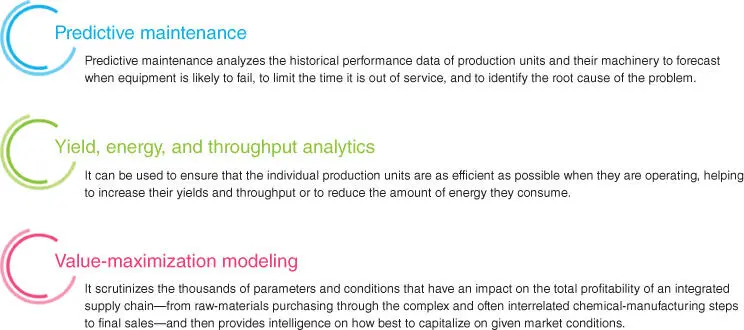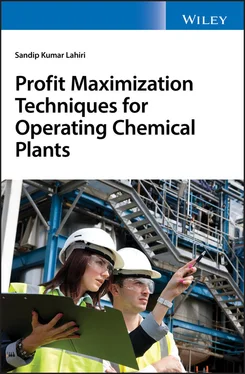There are three major areas where applications of advanced analytics tools can give an enormous profit increase, namely predictive maintenance; yield, energy, and throughput analytics; and value‐maximization modeling, as shown in Figure 2.3(Wang, 1999).

Figure 2.3Three major impact areas where advance analytic tools will help to increase profit
2.4.1 Decreasing Downtime Through Analytics
One of the major profit suckers in chemical industries is a sudden trip of critical single line equipment. Once a plant trips, millions of dollars get lost in terms of less or no production and more time is required to bring back the plant to on‐spec production after a disturbance. Besides this, a lot of money is lost in terms of flaring, venting, or draining of costly chemical gas or liquids (Wang, 1999).
Big data analytics can be used to develop fault diagnosis software to anticipate the failure of critical equipment at a very early stage and thus give sufficient time to plant engineers to take preventive or corrective actions. Such fault diagnosis systems analyze historical data to generate insights that cannot be observed using conventional techniques. By implementing an intelligent analytics‐based fault diagnosis system, companies can determine the circumstances that tend to cause a machine to break. Then a real‐time automated system can be developed to monitor all relevant parameters and give early fault signals, so engineers can intervene before breakage happens, or be ready to replace a component when it does, and thus minimize downtime. Companies who has implemented such systems typically reduce machine downtime by 30 to 50% and increases machine life by 20 to 40% (Wang, 1999).
Chemical companies are already starting to see substantial gains in this area. One major polymer producer consistently ran into problems with extruders at its largest plant. When one of the shafts of the extruder broke, the plant had to stop production for 3 days while a replacement was installed; these shafts are expensive, besides the cost impact of the production loss. Engineers had done a detailed study to determine the possible root causes of failure; alternative materials in the shaft were also tried out, as well as different process conditions, but none of them solved the problem.
A principal component‐based fault diagnosis approach changed all this. It combined a detailed analysis of data from hundreds of sensors with the plant engineers' expert domain knowledge, and reexamined the process variables and other data sources; it then developed a real‐time‐based algorithm to predict when a failure was imminent. The problem occurred with only one of the polymer grades, and not with all batches, suggesting the key lay in specific process conditions in the equipment. The team developed a model based on “a hybrid principal component analysis and artificial neural network” algorithm that took into account the specific parameter settings in production, such as extremes of temperature and temperature progression, together with information on the polymer product type and composition.
A real‐time visual platform was developed, which flagged an early warning to engineers when the plant conditions approached a state that could ultimately lead to shaft failure.
When it flags that a failure is imminent, the plant operators undertake a 15‐minute cleaning of specific parts of the machinery to prevent the failure from occurring. The improvements to performance that resulted from using the advanced‐analytics approach have been substantial. Instead of a 3‐day production loss plus a costly extruder shaft replacement, the company was now dealing with just a 15‐minute production interruption, and the approach has cut production losses by 60% and maintenance costs by 85%.
2.4.2 Increase Profits with Less Resources
Increasing plant throughput is the best and most effective way to increase plant profit. In plant, every equipment has some extra margin rising from its design safety margin. Advance analytics can scrutinize the past 3–4 years of plant operation data and can estimate how much capacity increase is possible in the plant without investing a single penny. AI‐based optimization techniques can then be used to optimize process parameters so that these safety margins can be exploited to increase plant yield and throughput or minimize energy costs. Even small percentage improvements in operational efficiency can significantly enhance earnings before interest, taxes, depreciation, and amortization (EBITDA) performance. The approach does that by balancing yield, energy use, and throughput – while also taking account of varying raw materials costs – to maximize the profitability of each process step (Wang, 1999).
One petrochemical company was having capacity limitations at its naphtha cracker furnace that makes ethylene and propylene. The furnace's unstable production rate and low overall output meant that it represented a serious bottleneck for a high‐margin segment of output. An artificial neural network and genetic programing‐based furnace model building exercise was carried out. All the temperature, pressure, flow, and composition data related to the furnace had been collected over 3 years of production, comprising 900 000 samples, each with 360 tags – almost 80 million data points. This analysis identified critical process parameters and made it possible to build a data‐driven furnace model. The model generated mathematical relations between the furnace throughput and other input parameters that can influence the throughput. By running the models at different input conditions, a deeper understanding of furnace operations is generated. A test run of the furnace confirmed the model's findings. The plant engineer had long suspected that manipulating some of the levers identified in the model could improve productivity, but they never had the mathematical tools or data to confirm it. Based on its new advanced analytics‐based understanding of its process, the company developed an automated, real‐time‐based operator guidance platform that advises the operators how to adjust a range of process parameters to get the best performance. The result was an output increase of 10 to 15%, which represented a net profit‐contribution increase of around USD 15 million a year. The company estimates that applying the same kind of advanced‐analytics approach across all the different manufacturing operations at the site could generate a USD 75 million annual profit gain (Holger Hürtgen, 2018).
Advance analytics can also be used to develop a data analytic platform to show a companywide energy usage pattern and guide the operators to change various energy usage options to minimize energy consumption. AI‐based techniques are sometimes use for a simple process, such as how to exploit favorable seasonal conditions (say a less cooling water temperature) to improve plant profitability.
2.4.3 Optimizing the Whole Production Process
Whereas predictive maintenance and yield, energy, and throughput analyses are designed to improve the efficiency and profit‐making capability of individual pieces of equipment, value‐maximization modeling covers the whole plant or whole site and helps to optimize the interaction between those pieces of equipment across processes. This optimization and modeling technique utilizes its inherent analytic capability to show in real time how to maximize the rate of profit generation in complex production systems and supply chains, encompassing every step from purchasing to production to sales. Unlike the limitations of human planners, this advanced‐analytics approach typically solves the complex maze comprising as many as 10 000 variables and one million constraints to help producers figure out what to buy and when, what to make and how much, and how they should make it to generate maximum profit in each period (Wang, 1999).
Читать дальше













